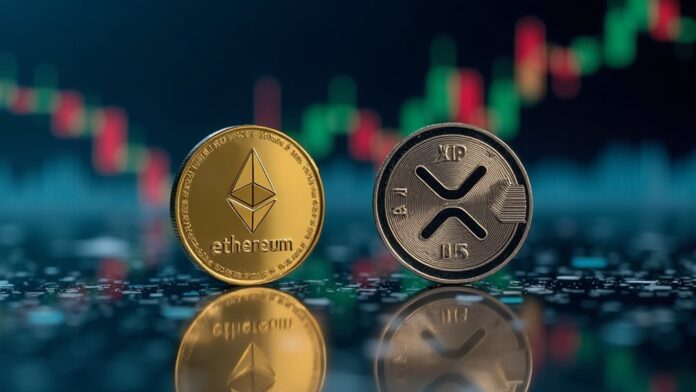Investors weighing a $5,000 investment in XRP versus Ethereum should consider Ethereum’s strong historical returns, substantial market capThe total value of a cryptocurrency, calculated as price mul, and upcoming technological upgrades like increased TPS for future-proof scalabilityThe capability of a blockchain network to handle increasing. XRP, however, offers unique advantages with its low-cost, quick transactions beneficial for financial institutions, enhanced by a resolved regulatory status. Analyzing these factors highlights Ethereum’s growth potential, while XRP offers efficiencies in specific financial applications. Exploring further will provide deeper insights into these investment avenues.
Why choose between XRP and Ethereum? Investors are often faced with this decision as they navigate the dynamic world of cryptocurrencyA digital or virtual currency that uses cryptography for sec. Analyzing historical performance and returns provides a foundation for informed investment strategies.
Ethereum has consistently delivered strong annualized returns, bolstered by its leading role in decentralized applications and the DeFi sector. Its price action in 2025 suggests potential for breakout moves, with targets around $1,960 attracting continued investor interest.
Meanwhile, XRP has shown remarkable growth since 2024, achieving over 350% gains since the U.S. election that year, outperforming Ethereum during this period. Despite experiencing short-term declines in May 2025, XRP’s six-month performance surpasses Ethereum’s 10% increase and even Bitcoin’s 58% gain.
Market trends also play an essential role in shaping investment strategies. Ethereum’s substantial market cap and broad adoption underscore its position as a major player, with a deep and liquid market that facilitates easy entry and exit for investors. Its circulating supply dynamics, influenced by network incentives, add a layer of complexity that savvy investors must consider. Ethereum displaying a bullish inverse head-and-shoulders pattern against Bitcoin further strengthens its market position, offering an additional technical advantage for investors.
On the other hand, XRP commands considerable liquidityThe ease with which an asset can be bought or sold without a and trading volumeThe total quantity of cryptocurrency traded within a specifi, driven by strong institutional backing and its role in cross-border payments. This heightened investor interest often spikes around news events and regulatory milestones, reflecting the market’s responsiveness to external factors.
In terms of technology and scalability, Ethereum’s blockchainA decentralized ledger that records transactions across a ne supports smart contracts and dApps, serving as a platform for Web3 innovation. Its current transaction throughput of 50–60 TPS is set to improve markedly with upgrades aiming for 100,000 TPS, addressing scalability challenges that have long been a focus.
XRP, optimized for fast, low-cost transactions, boasts a capacity of approximately 1,500 TPS, making it particularly attractive for financial institutions. Its design prioritizes speed and cost-efficiency, aligning with the needs of payment networks and offering a distinct advantage in seamless cross-border transactions.
The regulatory environment further influences the investment landscape. XRP’s historical legal challenges with the SEC were resolved by March 2025, reducing regulatory uncertainty and potentially paving the way for larger institutional adoption. This clarity is a positive factor for investors considering XRP. The supply and demand dynamics play a significant role in cryptocurrency price movements, influencing both XRP and Ethereum’s market performance.
In contrast, Ethereum has largely avoided major regulatory conflicts, though the evolving rules surrounding DeFi and tokenA digital asset issued on a blockchain, often representing v securities could impact future compliance requirements. Both cryptocurrencies remain under global regulatory scrutiny, with compliance developments continuing to affect investor risk assessments.
Ultimately, choosing between XRP and Ethereum requires a nuanced understanding of these factors. Investors must weigh the potential returns against the risks, considering how each cryptocurrency aligns with their broader investment strategies. Given the geopolitical developments affecting XRP’s price movements, investors should remain vigilant to external factors that may influence their investment decisions.



